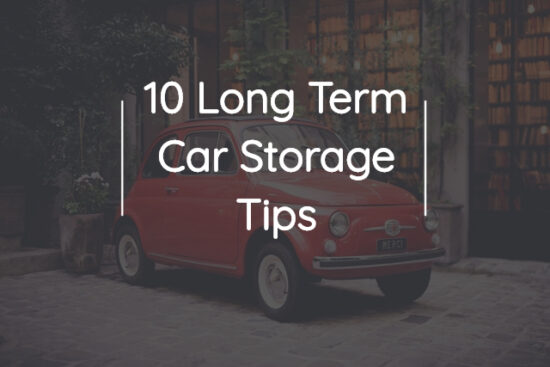Before, long-term car storage may have never crossed your mind; that is, until you invested in a classic car (to take out on the occasional joy ride) or splurged on a soft-top convertible that you only plan to use in the summers. If you’ve recently received notice of a six-month deployment, long-term storage may be a new pain point.
Regardless of the reason, you may find yourself desperately seeking a place to store your car–the car you don’t have room for in your garage, the car that’s hogging up space in your driveway, the car that needs a safe place while you’re away.
If long-term car storage is what you need, you’ll want your car to be protected from debris, lurking carjackers, and even internal damage.
Want your car to look and run like it did before you put it in storage? Here are a few long-term car storage tips to keep in mind.
What is Long-term Car Storage?
Long-term car storage refers to the storage of a car for extended periods of time, typically for a minimum of three months.
Long-term car storage is a great option for those who aren’t using their vehicle regularly and want to keep it safe, rather than merely leaving it unattended on a driveway or public street.
There are many different long-term storage options available through storage marketplaces like Neighbor. Once you’ve made your choice, you can start prepping your car for the storage period.
10 Tips for Long-Term Car Storage
A Step-by-Step Overview
- Fill up the tank
- Change the oil
- Put the car on jacks
- Wash and wax
- Plug the tailpipe
- Don’t use the parking brake
- Park your car on a plastic sheet
- Clean and dust the interior
- Cover your car
- Park your vehicle in the right spot
Fill up the gas tank
Before you park your car for the long term, make sure you’ve filled up the gas tank. While this may sound counterintuitive to fill up the tank before long periods of inactivity, if your gas tank is empty, there is a risk that it will culminate in rust, which is a hassle to deal with later on.
To protect your car from internal tank damage, you’ll also want to add a corrosion inhibitor fuel stabilizer to your fuel lines. Once the inhibitor is added, go on a quick drive to make sure it disperses throughout the engine.
If you’re storing your car for longer than a year or two, plan to replace the pre-storage fuel post-storage. Ultimately, the gas you’re putting in the gas tank is a preventative measure, meaning you shouldn’t plan to drive on that two-year-old fuel. Instead, you will need to empty your fuel tank and refill it.
Change the Oil
Like fuel, you also want to replace the engine oil. Used engine oil contains material that could damage the other components of the engine if it’s left in the car too long. You can also apply lubricant to the other parts of your engine to keep them greased and clean.
After taking your car out of storage, the last thing you’ll want to deal with is costly internal damage. A quick oil change–averaging between $35-$75–will spare you the headache of paying thousands in repair costs.
Put the car on jack stands
When a car is stored long-term, there is always a risk of flat spots forming as a result of the consistent weight being applied to one localized section of the tires. Jack stands can mitigate this pressure and prevent tire deformation.
If you do end up with flat spots, replacing the tires post-storage may be inevitable. To avoid this, take the car out for a spin every couple of weeks.
Fair warning: Some cars will not do well on jack stands and could end up warping the structure of your vehicle. Check your car owner’s manual first to see if your car falls into this category. You can also check online forums for insight into whether your car can handle extended time on jack stands.
Wash and wax
While you should always keep your car washed, it’s especially important to wash the car–and even wax it–before you put it into long-term storage.
Dirt, grease, and other sorts of debris and dust on the car can lead to oxidation and discoloration long-term. Fortunately, the wax adds another level of protection to prevent moisture between the metal and the elements.
Plug the tailpipe
Plugging your tailpipe will help prevent any air, critters, and other undesirables from sneaking into the pipe and causing possible damage to the car. You can plug the tailpipe with aluminum foil or a rag–just be sure to take it out before you drive again.
Another way to keep animals and bugs away from your car is to lay mothballs, or cotton balls dipped in peppermint oil around the perimeter of the car. Mouse traps are great for fending off larger critters such as mice and rats.
Some other entry points may include the air control valve and loose windows. Be sure to seal these openings before storing your vehicle for a several-month span.
Don’t use the parking brake
Here’s a quick and easy long-term storage tip: don’t use the parking brake. If the parking brake connects for too long, it can fuse with the interior of the wheel. Instead, use a wheel chock. For a more affordable solution, wedge a piece of wood under the tire to hold it in place.
Park your car on a plastic sheet
Parking your car on a large plastic sheet will help prevent rust from forming on your car if there happens to be excess moisture on the floor of your storage space.
Make sure the plastic is about a foot or two larger all around the perimeter of the car.
Clean and dust the interior
When cleaning and dusting the interior, make sure to:
- Vacuum and dust
- Wash the interior windows
- Wash any leather with water and soap or saddle soap
- Check glove compartments and trunks
- Remove anything that may cause smells or deteriorate over time
- Cover your car
To cover your car, don’t use a sheet, duvet, or tarp, as these fail to cover the car tightly enough. If moisture sneaks between the cover and the car, it can damage the paint job, metal, and even the fuel injection system.
A high-quality breathable car cover is made from fibers that are soft and breathable while still wrapping tightly around the car.
Park your vehicle in the right spot
Photo by Stefan Riedl on Unsplash
A key aspect of long-term storage is finding the right storage location. While traditional self-storage facilities are a popular option, there are other options that are more affordable and safe, such as Neighbor, the Airbnb of storage, where you can rent a neighbor’s garage to keep your car safe.
Bringing Your Car Out of Long-Term Storage
Perform a Thorough Inspection
Once your car has been parked for an extended period of time, especially in cold weather, it is crucial to perform an inspection. Extreme cold can be hard on your car, so you’ll need to confirm that your vehicle is free of damage, such as buildup or wear from contaminants or flat spots on the tires.
Give Your Car a Good Clean
After storage, give your vehicle a thorough clean. This is an essential step in ensuring your car looks clean and pristine. It can also help with the long-term buildup of mold or grime.
Take it Out for a Spin
Before integrating your car back into your daily routine, take your car on a short drive to make sure everything is operating as it should. This “test drive” of sorts may include checking the car battery, ensuring the tank is full, and seeing whether the driving seems smooth overall.
Don’t hesitate to bring it into a car shop if something feels off for a quick check-up.
What Long-Term Storage Options Are Available Near You?
The best option for long-term car storage is indoor, climate-controlled storage–as these types of spaces keep your car protected from harsh weather, traffic, and theft.
Check out Neighbor, a peer-to-peer storage marketplace–whether you settle on indoor car storage or outdoor car storage.
Photo by Peter Broomfield on Unsplash
Disclaimer: The information provided in this article is intended for general guidance and informational purposes only. Safety practices and regulations may vary based on your location, the type of vehicle, and local laws. Always prioritize your safety and the safety of those around you when handling fuel and operating a vehicle. The author and the website are not liable for any actions taken or consequences resulting from the use of the information presented in this article. Your safety is your responsibility, and we encourage you to take it seriously.







